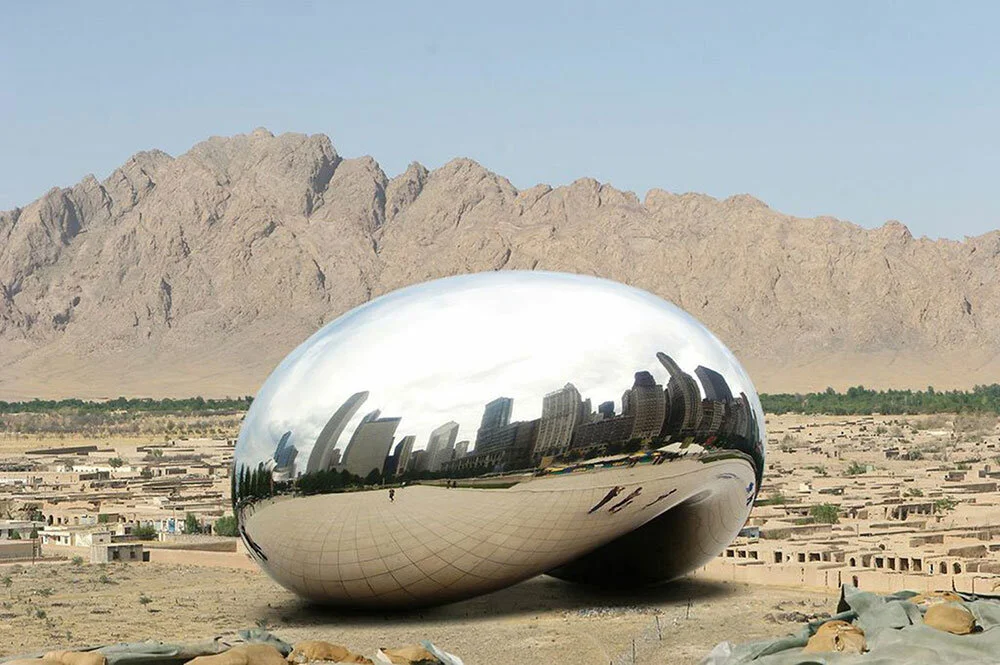Anish and Antony Take Afghanistan – Graphic novel which sees Kapoor and Gormley deployed by the United Nations
Around about 2012, I became very interested in public sculpture. More particularly, I became interested in how public sculpture was deployed – certainly in Britain, but elsewhere too – as a ‘Band-Aid solution’. In the first decade of the new millennium, gigantic public sculptures had begun to appear in ‘post-industrial’ areas: the government sponsored logic being that they would create focal points for industry, ‘culture’, local pride and ultimately, regeneration.
In Britain, the two greatest stars (and beneficiaries) of this shift towards public sculpture as a catalyst for social change, were Antony Gormley and Anish Kapoor. As early as 1994, Gormley – supported by a Tory government and local Labour council – had set the benchmark, when work on Angel of the North started in Gateshead, Tyne and Wear.
It’s tempting to say that the Angel of the North was intended to create the ‘Bilbao effect’ in the North East of England; but the Frank Gehry-designed Guggenheim Museum in Bilbao, credited with rejuvenating the ailing port town by turning it into a ‘must visit’ tourist destination, did not open till 1997.
In this respect, Angel of the North was – if we exclude Blackpool Tower and host of other historical constructions that were built purely to make ‘nowhere’ ‘somewhere’ – genuinely pioneering. The problems arose when Angel became the template for public sculptural gigantism as the easy-fix saviour of towns in industrial decline: see Kapoor’s Temenos (2010) in Middlesbrough – comically billed as ‘Britain’s longest public sculpture’.
Anish Kapoor, Temenos,, 2010, Middlesbrough, UK: ‘Longer than a 747 jumbo jet, as tall as Nelson’s Column’.
So, it was this idea of ‘gigantic public sculpture as economic saviour’ that interested me. The fact that, under the New Labour government (1997-2010), the implementation of public sculpture had become seen as a quick fix – a cheap replacement for investment in infrastructure – led me to thinking about how this might be deployed elsewhere.
What if Anish Kapoor and Antony Gormley were sent to Afghanistan? A country torn apart by religious divisions, Western military intervention and poverty. Could Anish and Antony fix that?
Anish Kapoor’s Cloud Gate, 2006, transplanted from Millennium Park, Chicago, USA to Helmand Province, Afghanistan.
My initial idea what to create ‘sculptural transplants’ – I’d Photoshop Anish and Antony’s work into the plains of Helmand Province. This didn’t work, it was too easy, too trite. So I began to think about the story – ‘how would Anish and Antony be commissioned to do this?’ – ‘what is the relationship between the two artists?’ – ‘what would be the consequences of covering Afghanistan in in gigantic public sculptures?’
After a few weeks of this, I could only see these images as the kind of heroic and macho drawings of 1960s/70s Victor and Hotspur annuals – the kind where a lone and plucky British commando wipes out entire Panzer divisions using only his penknife.
I asked around, wondered if anyone knew anyone who could draw like this. Will Henry got in touch with me. “I can do that,” he said. And he did, brilliantly. Within a couple of weeks we had the entire story and all Will’s rough sketches – I was amazed at how his drawings brought the story to life.
It was so utterly convincing, and Will’s skill, as well as the graphic novel form, meant that the story could go absolutely anywhere – and it did – Scott King
Anish and Antony Take Afghanistan, shown as part of the solo exhibition Totem Motif, Between Bridges, Berlin, 2014.
Anish and Antony Take Afghanistan, Herald St, London, 2015.
This work was originally created for a solo show entitled Totem Motif at Wolfgang Tillmans’ Between Bridges gallery, Berlin, 2014. It was then made into a book, Anish and Antony Take Afghanistan, published by JRP|Ringiner, 2014.
Illustration: Will Henry
RELATED CONTENT





